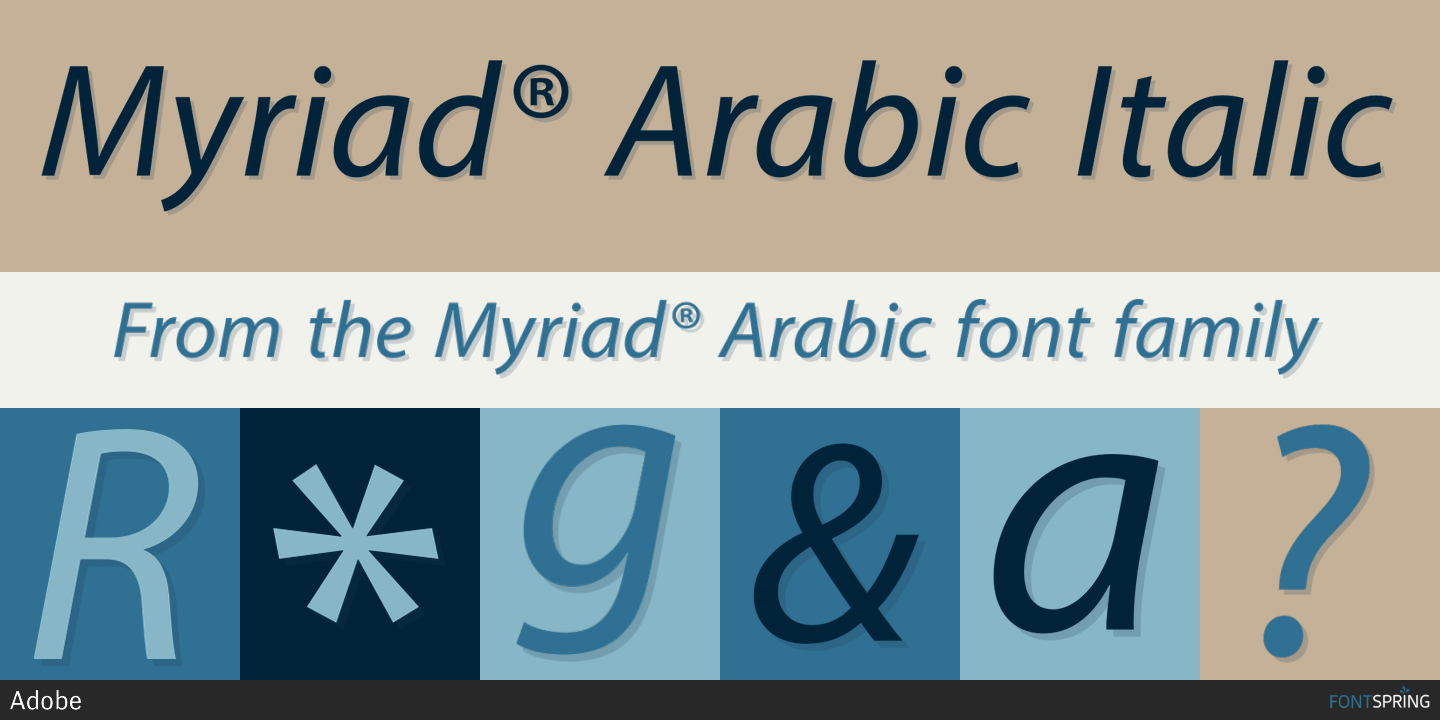Adobe Arabic Font For Mac
The Old Kufi had around 17 letter forms, and no accents or diacritic dots. Later, they were added, primarily to help with pronunciation, resulting in the set of letters rising to 29, including the Hamza. The driving force behind the unification of all these Arabic scripts was actually the Islamic font used in the Qur’an, as a consequence to the birth of Islam. One well-structured Arabic script, which had 29 letters, was developed for the holy scripts of the Qur’an, in the seventh century AD. The Qur’an was primarily written with the Quranic Kufi script, and the Quranic Naskh style afterward. Due to the Islamic conquests, the Arabic alphabet spread to all the Middle East, North Africa, and even some parts of Spain.

Oct 04, 2011 Will Acrobat not embed the correct font within the document, Tom, so that the user doesn't need to have the font installed on the computer? It's worth a try perhaps, but the problem is that the 'correct' font for Windows (Arabic Transparent in this case) will not normally display usable Arabic on a Mac. Download Adobe Gurmukhi Bold, font family Adobe Gurmukhi by Adobe Systems Incorporated with Bold weight and style, download file name is Adobe Gurmukhi Bold.otf. Download Adobe Gurmukhi Bold [PC/Mac] Use as Web Font. Share This Font. Adobe Arabic Bold Italic - Bold Italic. Adobe Garamond LT Bold - Regular. A font is a complete set of characters—letters, numbers, and symbols—that share a common weight, width, and style, such as 10‑pt Adobe Garamond Bold. Typefaces (often called type families or font families) are collections of fonts that share an overall appearance, and are designed to be used together, such as Adobe Garamond. A type style is a variant version of an individual font in a. Adobe Font Folio 11.1 is a collection of more than 2,400 OpenType® fonts from the Adobe Type Library. With award-winning typefaces, unsurpassed quality, and innovative features, Font Folio is a typeface collection for virtually any typographic task.
But you have a major misconception I should clear up. Support for Arabic and middle eastern languages was not “ripped out” from the regular version of InDesign – it was never there. Adobe licenses the InDesign code to a third party, Winsoft, who add the middle eastern support to their own version of InDesign, which they sell. The situation with Chinese support is a bit more complicated, and is explained. Well-done + Congratulations!Out of Arabic Adobe OTF, I have made 2 complementary fonts with:1.
The utilities in macOS Recovery help you restore from Time Machine, reinstall macOS, get help online, repair or erase a hard disk, and more. MacOS Recovery is part of the built-in recovery system of your Mac. How to image a mac for restore. Click on your Mac's startup drive in the Disk Utility sidebar. It should be the drive at the top of the sidebar if there are multiple drives. Click First Aid. First Aid will run, checking the health of your Mac's drive. This process could take a little while. Click Disk Utility in the Menu bar. Click Quit Disk Utility.
Arabic Font In Photoshop 7
Is it possible to use my old Arabic collection fonts? You can use almost all old Windows Arabic fonts including fonts whose names starts with ACS/MCS/FS/AF etc. Is it possible to import an Arabic document from Microsoft Word Document? No Problem, You could Import Microsoft Word Document Directly into Arabic Genie.
Download Arabic Fonts Free
If using a PostScript printer on Windows NT 4.0, AdobePS printer driver 5.1.2 or later is recommended. Mac OS • PowerPC® G4 or G5 or multicore Intel processor • Mac OS® X • 16MB of RAM (32MB recommended) Note: Adobe® Devanagari runs on Mac OS 8.6 through 9.2 with ATM Light 4.6.
Adobe Arabic Font For Mac
He’s talked about this at a few conferences, but the short version is: – developed the font in, using cubic Bezier outlines (for Type 1 and CFF) – exported an OpenType TrueType version to do the VOLT work with (note: must be careful to set FontLab’s options to NOT reorder glyphs at export time) – added the OpenType tables to the TTF file with VOLT – exported an OpenType CFF version of the font from FontLab. The two versions have identical glyph complements and glyph ordering, meaning that glyph IDs (GIDs) are constant. – [see below for update on this point] extracted the relevant OT layout tables from the OT TTF and glued them into the OT CFF. Mac programming tutorial. This can be done with a number of tools, including some in the, or the open source (which is also in the AFDKO these days, come to think of it). With TTX, one would dump both fonts to the TTX XML format, copy and paste the tables from one to the other, and recompile with TTX. You’ll need to know enough about the format to understand which tables you need and which are specific to TT outlines to avoid the latter.